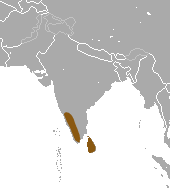| Stripe-necked mongoose | |
|---|---|
 | |
| Adult in Nagarhole National Park | |
| Scientific classification | |
| Domain: | Eukaryota |
| Kingdom: | Animalia |
| Phylum: | Chordata |
| Class: | Mammalia |
| Order: | Carnivora |
| Suborder: | Feliformia |
| Family: | Herpestidae |
| Genus: | Urva |
| Species: | U. vitticolla |
| Binomial name | |
| Urva vitticolla (Bennett, 1835) | |
 | |
| Stripe-necked mongoose range | |
| Synonyms | |
Herpestes vitticollis | |
The stripe-necked mongoose (Urva vitticolla) is a mongoose species native to forests and shrublands from southern India to Sri Lanka. [1]



